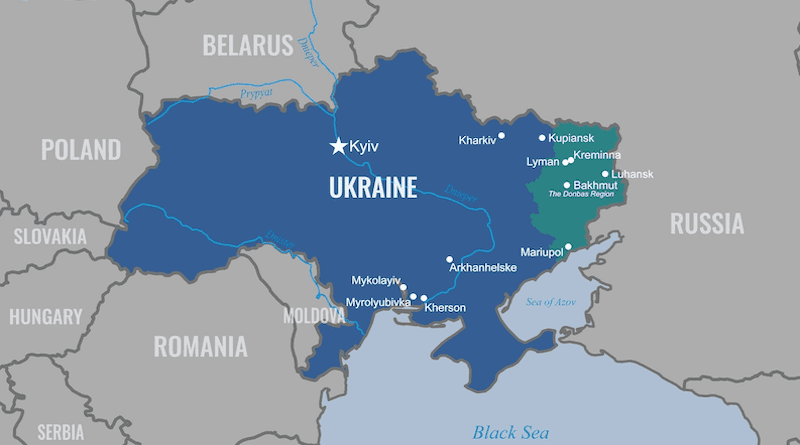Russia Claims Advances In Luhansk: Ukraine Says Situation ‘Difficult’
By RFE RL
(RFE/RL) — Russia has claimed its forces have broken through parts of Ukrainian defenses in the eastern Luhansk region, while Ukraine’s military says its troops are repelling some attacks, but the situation is difficult.
The intensifying fighting on February 15 came as Ukraine pleaded with Western allies to speed up the supply of weapons and NATO defense ministers met for second day to discuss the issue.
It also comes as Russia’s newest offensive ramps up in the Donbas region, and its forces — both regular troops and mercenary soldiers — press a monthslong effort to capture the Donetsk region city of Bakhmut.
Ukraine’s General Staff said on February 15 that the focus of fighting was around not only Bakhmut, but also Lyman, Avdiyivka, and Kupyansk.
Russia’s Defense Ministry claimed on February 15 that its troops had broken through two fortified lines of Ukrainian defenses, but did not specify exactly where. Not long after, President Volodymyr Zelenskiy’s office issued a statement saying Ukrainian forces had turned back some attacks in Luhansk, but the situation was difficult.
Live Briefing: Russia’s Invasion Of Ukraine

RFE/RL’s Live Briefing gives you all of the latest developments on Russia’s ongoing invasion, Kyiv’s counteroffensive, Western military aid, global reaction, and the plight of civilians. For all of RFE/RL’s coverage of the war, click here.
“Even the more fortified second line of defense of the enemy could not hold the breakthrough of the Russian military,” the ministry said in a post to Telegram.
Not long after, however, President Volodymyr Zelenskiy’s office issued a statement saying Ukrainian forces had turned back some attacks in Luhansk, but that the situation was difficult.
And Serhiy Hayday, the head of the Luhansk regional military administration, said that Russia was pouring men and equipment into the region.
“There is a lot of shelling, aviation is already involved. Attacks are coming in waves from different directions,” Hayday said in a video posted to his Telegram channel. “We see that they are transferring mobilized people. We also see that there is more equipment.”
In his nightly address on February 14, Zelenskiy warned that Russia was trying to lock in battlefield gains before more Western weaponry could arrive.
“I can say with confidence that the basic trends remain unchanged. Together, Ukraine and its partners are doing everything to ensure that the terrorist state loses. And for it to happen faster,” Zelenskiy said.
Meeting in Brussels for two days of talks, NATO defense ministers have tried to address concerns that Western stockpiles of weapons and ammunition are beginning to run low, while also finding ways to continue supplying Ukraine with weaponry.
Still, NATO officials have continued to resist Ukraine’s appeals to send fighter jets.
Speaking at a news conference in Brussels on February 15, U.S. Defense Secretary Lloyd Austin sounded an upbeat note about Ukraine’s fighting abilities.
“Russia continues to pour large numbers of additional people into the fight, and those people are ill-trained and ill-equipped and, because of that, we see them incurring a lot of casualties,” Austin said.
“I think [the Ukrainians] will have a real good chance of making a pretty significant difference on the battlefield and establishing the initiative. And being able to exploit that initiative going forward,” he said.
A day earlier, General Mark Milley, chairman of the U.S. Joint Chiefs of Staff, said that the number of countries that have pledged to send tanks to Ukraine has grown to 11; that 22 countries have pledged to send infantry fighting vehicles; 16 are sending artillery and ammunition; and nine are sending air-defense systems.
The most intense fighting at present is in the Donbas, around the city of Bakhmut, as well as to the north, near Kreminna, and to the south, near Vuhledar.
Russian forces have spent months trying to capture Bakhmut, which sits astride several major highways but whose strategic significance has been questioned by military analysts.
In recent weeks, Russian troops, including soldiers from the Wagner mercenary group, have made slow, incremental progress around Bakhmut; over the weekend, Wagner’s owner, St. Petersburg businessman Yevgeny Prigozhin, claimed his troops had captured a small, important village on Bakhmut’s northern outskirts.
“Bakhmut will not be taken tomorrow, because there is heavy resistance and grinding, the meat grinder is working,” Prigozhin said in a statement released by his press service earlier. He described “fierce” fighting unfolding on “every street, every house, every stairwell.”
The worst fighting continues to be near Bakhmut, Milley said.
“I would describe it as a war of attrition. The Russians are suffering huge losses,” he said.
Milley also highlighted the fact that many of the Russian soldiers fighting in the Donbas are former prison inmates, recruited by Wagner to fight in exchange for early release from their sentences.
Russia is sending conscripts and prisoners “to imminent death” while losing “strategically, operationally, and tactically,” he said.
Russian forces also appear to have suffered major losses of men and equipment around Vuhledar, a town 150 kilometers southwest of Bakhmut, according to Ukrainian and Western officials and open-source reporting.
Meanwhile, researchers at Yale University in the United States said that Russia had relocated thousands of Ukrainian children to a network of sites in Russian-occupied areas of Ukraine and in Russia.
The main goal of the effort is to “reeducate” the children to make them pro-Russian, the researchers said in the report released on February 14.

